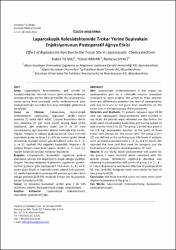Laparoskopik kolesistektomide trokar yerine bupivakain enjeksiyonunun postoperatif ağrıya etkisi
Özet
Amaç: Laparoskopik kolesistektomi, açık cerrahi ile karşılaştırıldığında minimal invaziv işlem olması nedeniyle postoperatif ağrı üzerine daha az etkilidir. Biz çalışmamızda, trokar yerine lokal anestezik verilip verilmemesine göre postopertaif ağrı açısından fark olup olmadığını göstermeyi amaçladık. Gereç ve Yöntem: Çalışmamıza, laparoskopik kolesistektomi operasyonu uygulanan 18-88 yaşları arasında 71 hasta dahil edildi. Çalışma kapsamına alınan tüm hastalara bir gün önce Vizüel Anolog Skala (VAS) anlatılarak, ağrı şiddetinin tayini için 0 ile 10 arası numaralanmış ağrı skorlama sistemi hakkında bilgi verildi. Olgular, rastgele iki çalışma grubuna ayrıldı. Grup 1 (n=34) bupivakain grubu ve Grup 2 (n=37) ise kontrol grubu olarak tanımlandı. Hastalar servise gönderildikten sonra da 2., 4., 6. ve 12. saatteki VAS değerleri kaydedildi. Hastaların ilk analjezi ihtiyacı olana kadar geçen süreleri ve 12. saat için toplam kullanılan analjezi miktarları kaydedildi. Bulgular: Çalışmamızda, bupivakain uygulanan grubun operasyon sonrası VAS değerlerinin düşük olduğu gözlendi. Gruplar karşılaştırıldığında bupivakain uygulanan grubun, kontrol grubuna göre postoperatif VAS skoru 2., 4., ve 6. saatte daha düşük ve istatistiki olarak anlamlı fark gözlendi. 12. saatte bupivakainin postoperatif aneljezi açısından etkin olduğu gözlendi (p<0.05). Analjezik ihtiyacı her iki gruptada benzer bulundu (p>0.05). Sonuç: Üç noktadan bupivakain verilen grup 1 de VAS skorlarının anlamlı derecede düşük olduğu kanaatindeyiz. Aim: Laparoscopic cholecystectomy is less impact on postoperative pain as a minimally invasive procedure compared to open surgery. We aimed to show whether there are diffferences between the level of postoperative pain due to it was or not given local anesthetics on the trocar area in the laparoscopic cholecystectomy. Materials and Methods: 71 patients between ages 18-88 who had laparoscopic cholecystectomy were enrolled in our study. All patients were informed one day before the study about Visuel Analog Scala (VAS) and scoring system of pain severity from 0 to 10. The group 1 (n=34) was given 3 mL (15 mg) bupivacaine injection at the point of three trocar sites (except the first trocar site). The group 2 (n = 37) was defined as the control group. VAS levels of patients were recorded at postoperative 2., 4., 6., and 12. hours. We recorded the time until first need for analgesia and the total amount of analgesia at postoperative 12. hour. Results: In our study, lower postoperative VAS scores for the group 1 were recorded when compared with the second group. Statistically significant decrease was observed in postoperative VAS scores of group 1 at 2. , 4. , 6. hours. Bupivacaine was found effective at postoperative 12. hour (p<0.05). Analgesia needs were similar for both of two group (p>0.05). Conclusion: We think that VAS scores are lower three point of given bupivacaine in the grup 1.
















